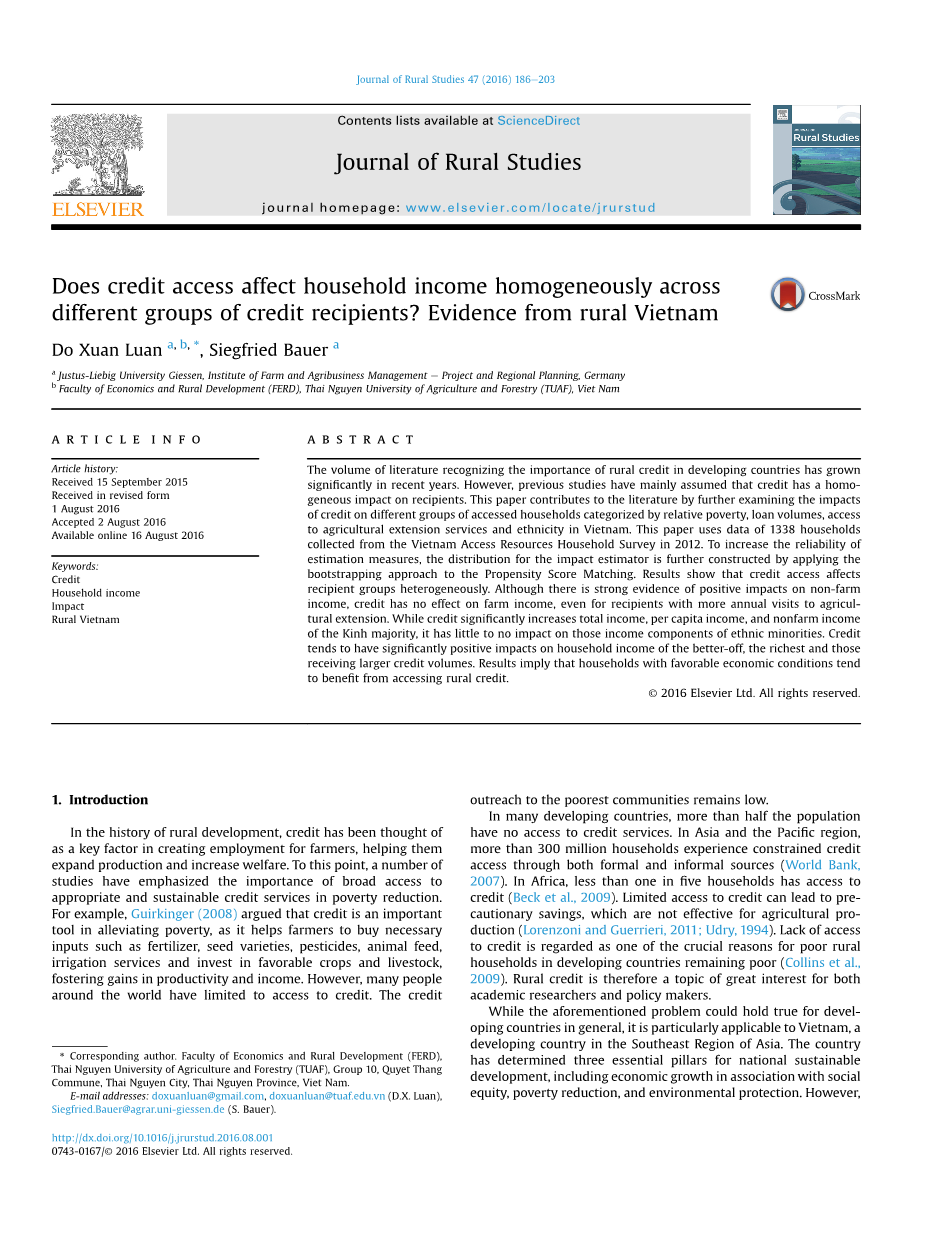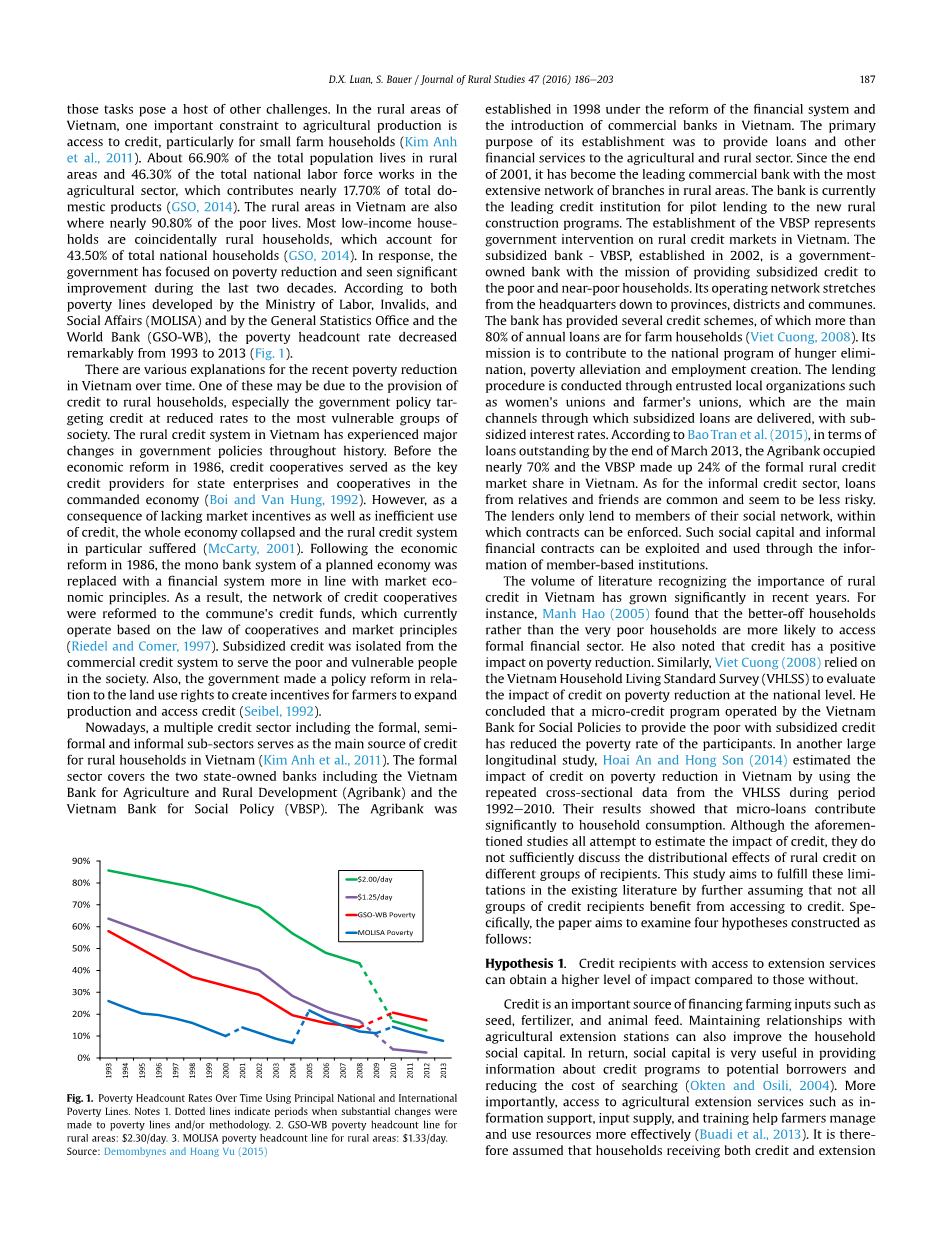

英语原文共 18 页,剩余内容已隐藏,支付完成后下载完整资料
Abstract:
The volume of literature recognizing the importance of rural credit in developing countries has grown significantly in recent years. However, previous studies have mainly assumed that credit has a homogeneous impact on recipients. This paper contributes to the literature by further examining the impacts of credit on different groups of accessed households categorized by relative poverty, loan volumes, access to agricultural extension services and ethnicity in Vietnam. This paper uses data of 1338 households collected from the Vietnam Access Resources Household Survey in 2012. To increase the reliability of estimation measures, the distribution for the impact estimator is further constructed by applying the bootstrapping approach to the Propensity Score Matching. Results show that credit access affects recipient groups heterogeneously. Although there is strong evidence of positive impacts on non-farm income, credit has no effect on farm income, even for recipients with more annual visits to agricultural extension. While credit significantly increases total income, per capita income, and nonfarm income of the Kinh majority, it has little to no impact on those income components of ethnic minorities. Credit tends to have significantly positive impacts on household income of the better-off, the richest and those receiving larger credit volumes. Results imply that households with favorable economic conditions tend to benefit from accessing rural credit.
1.Introduce:
In the history of rural development, credit has been thought of as a key factor in creating employment for farmers, helping them expand production and increase welfare. To this point, a number of studies have emphasized the importance of broad access to appropriate and sustainable credit services in poverty reduction. For example, Guirkinger (2008) argued that credit is an important tool in alleviating poverty, as it helps farmers to buy necessary inputs such as fertilizer, seed varieties, pesticides, animal feed, irrigation services and invest in favorable crops and livestock, fostering gains in productivity and income. However, many people around the world have limited to access to credit. The credit outreach to the poorest communities remains low.
In many developing countries, more than half the population have no access to credit services. In Asia and the Pacific region, more than 300 million households experience constrained credit access through both formal and informal sources (World Bank, 2007). In Africa, less than one in five households has access to credit (Beck et al., 2009). Limited access to credit can lead to precautionary savings, which are not effective for agricultural production (Lorenzoni and Guerrieri, 2011; Udry, 1994). Lack of access to credit is regarded as one of the crucial reasons for poor rural households in developing countries remaining poor (Collins et al., 2009). Rural credit is therefore a topic of great interest for both academic researchers and policy makers.
While the aforementioned problem could hold true for developing countries in general, it is particularly applicable to Vietnam, a developing country in the Southeast Region of Asia. The country has determined three essential pillars for national sustainable development, including economic growth in association with social equity, poverty reduction, and environmental protection. However, those tasks pose a host of other challenges. In the rural areas of Vietnam, one important constraint to agricultural production is access to credit, particularly for small farm households (Kim Anh et al., 2011). About 66.90% of the total population lives in rural areas and 46.30% of the total national labor force works in the agricultural sector, which contributes nearly 17.70% of total domestic products (GSO, 2014). The rural areas in Vietnam are also where nearly 90.80% of the poor lives. Most low-income households are coincidentally rural households, which account for 43.50% of total national households (GSO, 2014). In response, the government has focused on poverty reduction and seen significant improvement during the last two decades. According to both poverty lines developed by the Ministry of Labor, Invalids, and Social Affairs (MOLISA) and by the General Statistics Office and the World Bank (GSO-WB), the poverty headcount rate decreased remarkably from 1993 to 2013 (Fig. 1).
There are various explanations for the recent poverty reduction in Vietnam over time. One of these may be due to the provision of credit to rural households, especially the government policy targeting credit at reduced rates to the most vulnerable groups of society. The rural credit system in Vietnam has experienced major changes in government policies throughout history. Before the economic reform in 1986, credit cooperatives served as the key credit providers for state enterprises and cooperatives in the commanded economy (Boi and Van Hung, 1992). However, as a consequence of lacking market incentives as well as inefficient use of credit, the whole economy collapsed and the rural credit system in particular suffered (McCarty, 2001). Following the economic reform in 1986, the mono bank system of a planned economy was replaced with a financial system more in line with market economic principles. As a result, the network of credit cooperatives were reformed to the commune#39;s credit funds, which currently operate based on the law of cooperatives and market principles (Riedel and Comer, 1997). Subsidized credit was isolated from the commercial credit system to serve the poor and vulnerable people in the society. Also, the government made a policy reform in relation to the land use rights to create incentives for farmers to expand production and access credit (Seibel, 1992).
Nowadays, a multiple credit sector including the formal, semiformal and informal sub-sectors serves as the main source of cred
剩余内容已隐藏,支付完成后下载完整资料
资料编号:[468414],资料为PDF文档或Word文档,PDF文档可免费转换为Word
以上是毕业论文外文翻译,课题毕业论文、任务书、文献综述、开题报告、程序设计、图纸设计等资料可联系客服协助查找。


